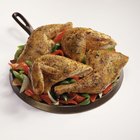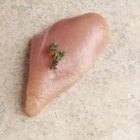
When you're new to cooking, preparing chicken might make you nervous. If it's overcooked the flesh will be relatively dry and flavorless, but if it's undercooked the chicken presents a food safety risk. It can be especially disconcerting if blood appears to be running out, along with the cooking juices. Fortunately, it's not as scary as it seems. Red or pink in the cooking juices is entirely normal, and food safety can be assured by using a thermometer.
The Juices
Most recipes instruct you to bake chicken "until the juices run clear." Those juices are usually pink while the chicken is cooking, but it's not because of blood. The muscle fibers in chickens, like other birds and animals, rely on a substance called myoglobin to carry oxygen to their cells. In the heat of the oven, those muscle fibers begin to contract as they cook. This means they can't hold as much liquid, and -- like squeezing a sponge -- some of the juices from the meat will begin to leak out. The myoglobin in the juices contains iron, which gives them a pink color when they leak out.
Running Clear
As the chicken continues to bake, the heat disrupts the chemical reaction that causes the myoglobin to appear pink. The juices cooking out from the chicken will lose their rosy hue, becoming clear. At that point they're a sort of extra-pure chicken broth. If you insert an instant-read thermometer into the thickest portion of the chicken at this stage, it should show a food-safe temperature of 165 degrees Fahrenheit or above. It's entirely possible your chicken can reach this temperature and still run blood or show a red color near the bone. These are also normal characteristics of modern chickens.
Running Blood
If the juices running from your chicken contain dark red streaks, as opposed to the pink of myoglobin, that's blood. It usually runs from the ends of the leg bones, in chicken legs or a whole roast chicken. The chicken's leg bones make a semiporous container for the bone marrow, where blood is manufactured. During cooking, the blood heats and expands, and forces itself out of the bone. If a thermometer shows your chicken to be at a food safe temperature, this isn't a concern.
Red at the Bone
It's also possible for properly cooked chicken to appear red, or even bleed, at the thigh bone. The femoral artery, which runs along the thigh bone, carries blood through the chicken's leg. Even after cooking, it might contain some dark red blood. It's unsightly, but not a food safety risk. It's also common for properly cooked chicken, especially young fryers, to be a deep pink or even red at the bone. This is because pigments in the bone marrow seep through the thin bones of these juvenile birds, tinting the meat with a heat-stable pigment. Again, this is not a food safety concern as long as your chicken has been cooked to a food safe temperature of 165 F.
Related Articles

Can Chicken Thighs Still Be Pink When ...

If Chicken Smells Bad Can You Still ...

Difference Between Fryer & Roaster ...

How to Get a Crispy Crust on Roasted ...

How Long to Cook a Chicken Hindquarter ...

Can I Cook a Whole Chicken Without ...

What Are Chicken Drippings?
Difference Between Roaster & Stewing ...

Can You Cook Bone-in Chicken in a Metal ...

Free Range Chicken Cooking Tips

Can I Cook Chicken Two Weeks After the ...

Can You Boil the Bacteria Out of ...

How to Cook Sauteed Chicken With White ...

What Happens to Boneless Chicken if I ...

Is It Safe to Bake Vegetables in the ...

How Long Do You Need to Boil Large ...

How to Defrost a Chicken in a ...
Can You Cook Frozen Chicken?

How to Tie a Rotisserie Chicken

Can I Cook Duck in Low Temperatures to ...
References
- On Food and Cooking: The Science and Lore of the Kitchen; Harold McGee
- Professional Cooking; Wayne Gisslen
Resources
Writer Bio
Fred Decker is a trained chef and prolific freelance writer. In previous careers, he sold insurance and mutual funds, and was a longtime retailer. He was educated at Memorial University of Newfoundland and the Northern Alberta Institute of Technology. His articles have appeared on numerous home and garden sites including GoneOutdoors, TheNest and eHow.
Photo Credits
Eising/Photodisc/Getty Images